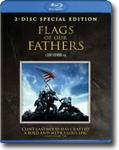 |
|
|||||||||||||||||||||||||||||||||||||||||||||||||||||||||||||
Clint Eastwood is a true artist who not only knows how to direct actors and make great films, but he has a real feel for conveying a beautiful sense of time and place. His Flags of Our Fathers Cluttered and convoluted, the film jumps backward and forward in time, uses not one voice-over narration but two (possibly three), has a circuitous narrative, and is topped off with a cast of thousands, featuring not only the brave boys who died on the island of Iwo Jima but their families - particularly their mothers - back at home. The film is a huge undertaking where Eastwood in particular concentrates on the fate of three survivors: Ira Hayes (Adam Beach), Rene Gagnon (Jesse Bradford) and author James Bradley's father, Doc (Ryan Phillipe). Little did the five Marines and a Navy corpsman who raised a heavy Japanese water pipe bearing the Stars and Stripes know that this would become one of the most defining images of the Second World War. The flag-raising was highly symbolic, a signal of victory that served to prop up a fatigued populace and at the same time helped to stem the rising pessimism in a U.S. that was fast becoming bankrupt and exhausted from the war in the Pacific. Still coping from battle fallout and the horrors of what they saw in Iwo Jima, Hayes, Gagnon and Bradley are pressed into service as public relations stooges for a war bonds tour. The officials who court them aren't really concerned about how they suffered or what they saw; they're far more concerned with getting the battle-weary populace to keep buying the bonds. Each of the boys handles this sudden fame in different ways, but it is Hayes who suffers the most as an American Indian whose sorrow for his fallen buddies is compounded by the racism he encounters at every turn. While Hayes turns to drink, Doc and Rene soak up the glory of heroism, knowing all the time that their fallen comrades who raised "the first" flag are the real heroes. Beach, Bradford and Phillipe are all good actors (and they look terrific), but they also come across as a bit bland and faceless. Of course, they all have the mandatory heft to show their inner turmoil, but they often appear as blank slates in the face of so much chaos. Eastwood does a great job of showing war, engendering a real sense of not only the inexpressible savagery of the battlefield, but also the vast wastefulness and pointlessness of war. But his decision to use a split narrative and jump back and forth between Iwo Jima and its aftermath causes the film to comes across as too disjointed. We should be totally absorbed in the story of these men. Instead, we're persistently shuttled back to their publicity tour, then back to the battle, then on back to the tour, which effectively nullifies any buildup in dramatic tension. Consequently, the film ends up being a visually stunning but rather muddled, mixed-up affair that, at almost 130 minutes, goes on too long and commits the sin of being boring when it should be engrossing, gripping and ultimately uplifting. |
|
|||||||||||||||||||||||||||||||||||||||||||||||||||||||||||||
|
||||||||||||||||||||||||||||||||||||||||||||||||||||||||||||||
| action | animation | art house/international | comedy | documentary | drama | family | horror/sci-fi | suspense | television | ||||||||||||||||||||||||||||||||||||||||||||||||||||||||||||||
| contact | home | ||||||||||||||||||||||||||||||||||||||||||||||||||||||||||||||



